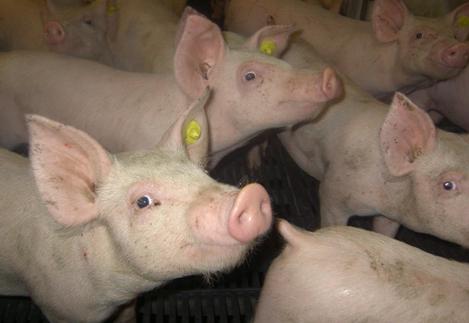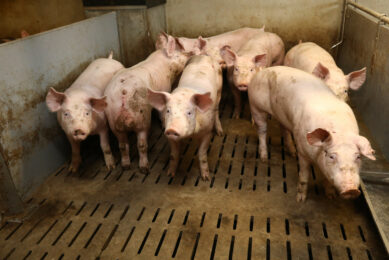More awareness of mycotoxins – Part 4. Mycotoxins: Major enemy of the immune system

Mycotoxins display immunomodulatory properties that can lead to reduced vaccine efficacy in pigs, as well as in other animals. Focusing on swine, this article aims to explain which mycoxins cause which immunomodulation.
By G.M. Meissonnier, INRA, laboratoire de Pharmacologie-Toxicologie, Toulouse, France and Alltech France; and I.P. Oswald, INRA, France
Mycotoxins are metabolic compounds produced by fungi that grow on growing or stored plant material. Mycotoxicosis causes multiple symptoms and problems, depending on the fungi involved and the conditions. However, immunomodulation problems are probably the most common factor resulting from ingestion of contaminated feed. Mycotoxin-induced immunotoxicity is significant for several reasons; from an agricultural standpoint, mycotoxin exposure may cause increased susceptibility of livestock to infectious diseases and so reduce productivity. From a public health perspective, transfer of toxins from animal products to humans can endanger health.
In addition, the increased antibiotic concentrations in meat or milk, as a consequence of animal treatment, may pose problems. The sensitivity of the immune system to certain mycotoxins may be due to the increased vulnerability of actively dividing and differentiating immune cells. Such high levels of activity are essential to insure their functions in the complex network of the innate and acquired immune response. As a result, the impact of mycotoxicosis on immunomodulation is often observed at low exposure level, when compared to other toxic compounds.
For vaccination to be effective, a competent immune system is needed to produce a rapid response during exposure to infections.
Vaccination is used to decrease the incidence and consequences of infection diseases in farmed animals. For vaccination to be effective, a competent immune system is needed to produce a rapid and appropriate specific response during exposure to infections. The capacity of mycotoxins to modulate immunity has potentially serious implications on the efficacy of vaccination.
Different mycotoxins can impair different parts of the immune system, and can be more or less dangerous depending on the species of animal exposed to them.
Aflatoxins
Aflatoxins mainly affect liver tissue and have carcinogenic properties, and display immunotoxic effects that specifically impair the cellular-mediated immune response.
Data from studies using pigs vaccinated with ovalbumin showed that aflatoxin B1 exposure had no major effect on the immune systems associated with immunoglobulins (Ig) circulating in blood plasma. Toxin exposure delayed and decreased immune cell proliferation, suggesting impaired lymphocyte activation in pigs exposed to the B1 toxin. However, in pigs vaccinated with Mycoplasma, exposure to low levels of aflatoxin B1 did not modulate the antigen-specific and total antibody response.
Trichothecenes
Trichothecenes such as deoxynivalenol (DON) have the capacity to genetically regulate immune function by disrupting communication systems within the leukocyte cells. In pigs immunised with OVA, ingestion of DON increased the circulating levels of total and anti-OVA IgA. DON does not appear to change lymphocytes proliferation patterns after stimulation, but the toxin has been seen to increase (up-regulate) cell proliferation in the days immediately following OVA immunisation and down-regulates the genes in subsequent weeks.
Type A trichothecenes, such as the T-2 toxin, are toxic to cells and can be potent protein inhibitors. In pigs immunised with OVA, sub-clinical doses of T-2 toxin fed for four weeks induced an early, but transient, increase of IgA levels, but a decrease in the anti-OVA IgG titre. For higher doses of exposure, T-2 toxin can decrease lymphocyte proliferation following a horse globulin immunisation.
Fumonisins induce various toxic effects, depending on the animal species involved, and there is evidence for this toxin to be involved in carcinogenicity. In vitro and in vivo experiments showed that fumonisin B1 modifies the cytokine balance in pigs, causing impaired humoral responses. Data from pigs vaccinated against Mycoplasma and exposed to fumonisin B1 for four weeks revealed a sex-related difference in the specific immune response. Toxin intake reduced the specific antibody titre, but only in male pigs. However, ingestion of the
contaminated feed had no effect on the blood serum concentration of IgG, IgA, and IgM.
contaminated feed had no effect on the blood serum concentration of IgG, IgA, and IgM.
Ochratoxin A
Ochratoxin A (OTA) mainly affects the kidney and liver tissues. Regarding immunity, exposure to OTA can increase susceptibility to infections, e.g. Salmonellosis in pigs. When chickens are exposed to OTA after vaccination against ND, they show reduced levels of haemagglutination inhibition antibodies. When viewed together, this can be considered to demonstrate that mycotoxins may have the ability to alter the antigen-specific immune response at both the humoral and the cellular level. Recent studies, investigating both cellular and humoral responses, have demonstrated effects on the immune system whereas other non-specific parameters were not affected in case of clinically ‘silent’ (asymptomatic) mycotoxin exposures.
Controlling immunotoxicity
The best and easiest way to alleviate the negative impact of mycotoxicosis in animals is to reduce the level of exposure to the toxins. Strategies to prevent mycotoxin contamination in food and feed should start in the field and continue during the storage of feed materials.
Numerous studies have investigated possible protection strategies using in-feed protective agents. These compounds interfere with toxin absorption, or work by inactivating toxins. Several of these agents have been tested in vitro, but in vivo experiments should always be performed to confirm their effectiveness, especially on animal performance, biochemical parameters, or histopathology. Currently few experiments have directly investigated in effects of in-feed protective agents on immune responses.
Studies in pigs (Table 1) have shown that different glucomannans exert benefits in terms of reducing the impact of mycotoxins in the animal. The tested compounds claimed different modes of action, for example:
• Competition with OTA using phenylalanine analogues (sesame seeds)
• Increased toxin elimination from the body (artichoke extracts)
• Potent immunostimulant (ß-D-glucan)
• Mycotoxin binder (glucomannans, clays)
Most of the published studies have confined their investigations to the humoral immune response. However, the use of vaccination can induce a cellular-mediated response that may be impaired by an exposure to mycotoxins, as seen with the aflatoxin B1-contaminated feed in pigs. Fish exposed to aflatoxin B1 and given feed supplemented with ß-D-glucans, had higher resistance to infections. However, this did not seem to be due to an improved antibody response, but may be explained by a heightened cellular mediated immune response, as seen for the pigs exposed to aflatoxin B1 which received feed supplemented with glucomannans.
Reducing mycotoxin exposure or decreasing the immunodulatory effects of mycotoxin by the use of in-feed protective agents (including toxin binders, antioxidants and other specialised compounds) can provide valuable strategies to protect animals from impaired immunity.
References available on request
Source: Pig Progress Volume 25 nr 7











